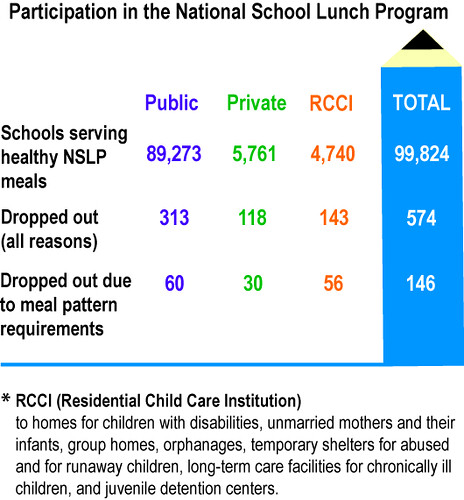The last few years have seen significant improvements to the health of the school environment. Schools across the country are increasing their efforts to prevent childhood obesity by serving healthier school meals providing more time for physical activity, and helping kids learn about proper nutrition. It’s clear that the new, healthier school meals implemented last year are working and having a positive impact on the health of our next generation.
We recently surveyed states and schools across the country, and the vast majority of schools—80 percent—have already reported that they are meeting the updated meal standards successfully, with some states reporting 100% of schools completely transitioned to the new standards. We expect the remaining schools to “make it official” soon, too. In fact, a study just released by the Kids’ Safe and Healthful Foods Project found that last year 94 percent of U.S. school districts said they were on track to meet the updated nutrition standards for lunches by now.
Our own survey shows that a very small percentage—only 0.15 percent of schools—have cited difficulty complying with the new standards as a reason for leaving the program. While we encourage the very few eligible school districts that have chosen not to participate in the school meals program to take steps to ensure all children will still have access to healthy, affordable meals during the school day, it is clear that the vast majority of schools and parents think that the new meals are working.

Even before the additional resources provided under the new standards were available, many schools were already leading the way in providing healthier options and appropriate portion sizes to kids. Positive stories are rolling in from across the country. I have even heard from a number of schools that adopted the changes early on that participation has actually increased as students and parents became accustomed to the healthier options.
And USDA has just released additional evidence that shows that more than half of public schools in 2005 were already meeting the new standard for fruit (60 percent) and many more were meeting the new daily standard for total vegetables (88 percent). The researchers also found that when kids were offered greater quantities of fruits and vegetables at lunch, they ate more of those healthy foods.
It’s important to remember that some schools weren’t as close to meeting the new standards, and they may need a little more time for their students to fully embrace the new meals. That’s why it’s such a priority for us to continue to provide flexibility and help to schools as they work toward full implementation. Some of our aid to schools includes technical assistance, school equipment assistance grants, and an additional six cents reimbursement for each lunch that meets the new standards.
Better child nutrition through improved school meals is one of the most important investments we can make in America’s future. A recent study in the journal Pediatrics suggests that efforts to establish healthy habits at an early age are working: kids ages 11 to 16 are eating more fruits and vegetables and consuming less sugar, getting more physical activity, and starting their days with a healthy breakfast. At the same time, the Centers for Disease Control (CDC) is reporting that the rate of obesity among low-income children appears to be declining, dropping for the first time in decades in some states. Yet childhood obesity rates still remain higher than we’d like, which we know can significantly impact children’s ability to learn, grow and reach their full potential. It’s clear that a healthier breakfast and lunch at school can make a positive difference in children’s diets and habits—making the efforts of parents, teachers, school nutrition professionals and communities to implement the new standards well worth the effort.
Editor's Note: This post was updated from a previous version.
